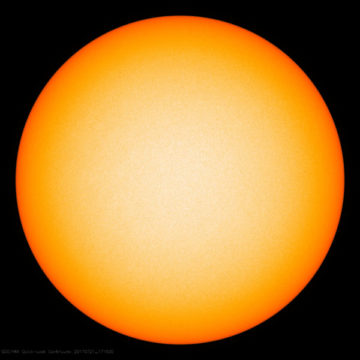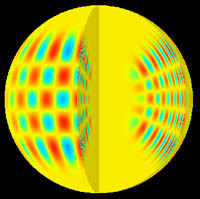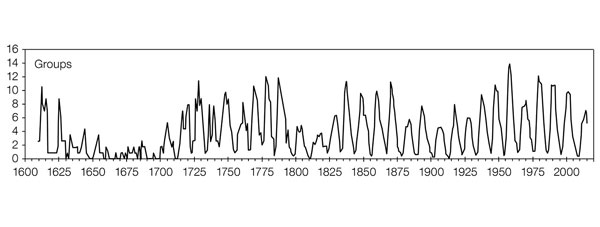The Sun, now halfway through its life, might be slowing its magnetic activity, researchers say, which could lead to permanent changes in the sunspots and auroras we see.
The Sun has changed its figure, researchers say, and might keep it that way.

NASA / SDO / HMI
The structure of the Sun's surface, where sunspots live, appears to have changed markedly 23 years ago. That’s when solar magnetic activity might have started slowing down, Rachel Howe (University of Birmingham, UK, and Aarhaus University, Denmark) and collaborators speculate in paper to appear in the Monthly Notices of the Royal Astronomical Society (full text here). Such a structural change might help explain the Sun's mysteriously weak cycles in recent years.
The interior of the Sun pulsates as rhythmically as a human heart. But while the heart pulses at one fairly steady frequency, the Sun reverberates at thousands of different frequencies. Pressure changes inside the Sun create these reverberations, just like pressure changes in the air create sound. The sound waves inside the Sun are outside the range of human hearing — they're too low frequency — but if we sped them up, we could hear them just like any other sound.
Some of these sound waves come from deep within the Sun, while others come from shallower layers. Since these sound waves can tell us about the structure of the solar interior, scientists measure them constantly using instruments like the Birmingham Solar-Oscillations Network.

Stanford University
Howe and colleagues collected 29 years of data on these sound waves, and they measured how much the waves’ frequency changed over time relative to a four-year period spanning 1988 to 1992. If the Sun were to stay pretty much the same, researchers would find no real difference between this four-year period and any other period. Instead, they were surprised to find that, since 1994, low-frequency sound waves have changed quite a bit compared with their behavior during the four-year benchmark. While higher-frequency sound waves changed too, it was by a much smaller amount. This confirms previous research, which has indicated a possible structural change in the surface layer of the Sun.
Then, the researchers compared the change in higher-frequency sound waves, which reverberate in the shallowest layer of the Sun, with the number of sunspots. In general, the two tracked each other pretty well over the years: the change in high-frequency sound waves went up and down with the number of spots during the Sun’s 11-year cycle of magnetic activity.
But over the last two solar cycles, the change in high-frequency sound waves exceeded the number of sunspots. This shift, the researchers reasoned, could mean that the waves were picking up on sunspots so small that they weren’t even recorded. If there are a lot more tiny sunspots than there used to be, and they're all confined to the shallowest layer of the Sun — well, maybe the Sun's surface is thinning and its magnetic activity is slowing down.
There is evidence that Sun-like stars slow their magnetic activity after reaching middle age. And the Sun is, in fact, at just that age. But while we might be seeing some evidence of a slow-down, the process will likely happen over thousands, if not millions, of years. Furthermore, this is not the first time that the Sun has deviated from previous behavior. During a 70-year period in the 17th century, the Sun shed all but a few of its sunspots, only to right its course again.

WDC-SILSO
And maybe we're not seeing a slow-down at all. While the strongest sunspot cycle rises and falls over the course of 11 years, there are other sunspot cycles that rise and fall over longer timespans. These other cycles could affect the 11-year cycle. So we can't yet conclude that the Sun's relatively recent changes are permanent. The best thing to do is just keep on looking: There are many more clues buried in the Sun's many heartbeats.
 4
4









Comments
July 22, 2017 at 10:02 am
Good article. I felt the comment about the Sun being middle aged was a bit presumptuous. How can we know what the Sun will do when all our observations amount to a very small fraction of it's lifetime? The proxies for ancient solar activity leave us with more questions than answers. The author summed up well by telling us to keep looking! Ignore our mothers advice and stare at the Sun. It has a great deal to do with our long term survival.
On a related topic, will this affect our climate? It might. Either directly through Total Solar Irradiance or indirectly through increased cloud seeding by cosmic rays. There is a dragon in the room who may breath fire on us, or not. Shouldn't we discuss it?
You must be logged in to post a comment.
July 28, 2017 at 6:26 pm
The Sun is approximately 4.5 billion years old. And it will last about another 4 to 6 billions years, give or take a billion or so. So to put this study into proper perspective and scale, let's talk about the length of this study - 29 years. Data was collected over 29 Earth years which means that if we were analyzing a human life of say 80 years, the study was conducted over - wait for it - the enormous time of just 0.000,000,516 years. That is far, far, FAR less than even one second of analysis of a human life time. So the heading of the story is totally unrelated and frankly, disconnected and disjointed, from the study itself. I am sure the authors of the study are wondering (or laughing) at the heading. Meanwhile, more important questions related to earth climate and its dependency on Solar cycles is utterly absent from the article. Why? Could it be that the Catholic editor also believes in the current dogma of human caused global warming and simply cannot or would not allow an article to be published that discussed the climate connection to the Sun?
You must be logged in to post a comment.
Peterelectric
July 29, 2017 at 1:13 am
I agree with mhawkins. The current obsession with man made climate change sweeping the world seems to have affected this articles objectivity somewhat.
Still, an interesting article nonetheless and unfortunately, it bodes ill for my other hobby, amateur radio. The lack of sunspots is causing very poor radio propagation on the HF bands.
You must be logged in to post a comment.
August 1, 2017 at 7:22 pm
Yes I think you answered your own question very effectively.
Given the age of the sun, an effect observed 23 or 29 years ago is unlikely to be a life-changing event. Especially since similar or sronger changes have been observed at other times.
You must be logged in to post a comment.
You must be logged in to post a comment.